#whole coriander spice
Explore tagged Tumblr posts
Text
#whole coriander seeds#coriander seeds uses#health benefits of coriander#cooking with coriander seeds#coriander seed flavor#medicinal properties of coriander#whole coriander spice#coriander seed nutrition
0 notes
Text
i didn’t post about it here yesterday but i made masala with a whole bunch of stuff in it (chickpea paneer AND tofu) (because i’m the boss and i get to do what i want) and it came out only ok (too much coriander, really old garam masala, weird taste) (edible but not ideal) and i just ate it as stew yesterday but today i made myself make basmati and eat it again as leftovers instead of ordering pizza. everybody clap
#did that thing where when you taste one little spoonful it doesn’t taste like much so you keep putting in spices and then when you eat#a whole bowl you’re like ‘oh wow…’#except it was mostly the coriander. and i put in too much clove also i think#i had to put in a bunch of sugar to make it less crazy. and lime juice#anyway i’m glad i made myself eat leftovers 👍#but i might order pizza tomorrow bc i have a free one from dominos 😈 and it’s wrasslin tomorrow#chatpost#REALLY wish i had chutney. ive never made chutney what goes in it it’s just like onions with sauce or something#i bet it’s easy to make but i wonder where i can get some. maybe i should go to the indian market tomorrow after work
11 notes
·
View notes
Text
Pure Hing, Jeera Powder & Ground Coriander Spice Blend
Enhance every meal with aromatic hing, earthy jeera powder, Lucknow Fennel Seeds, and fresh ground coriander—premium spices for rich, authentic Indian flavor. Enhance your dishes with Wabhai Foods' hing and asafetida ground. Infuse your cooking with a bold, aromatic touch to elevate its depth and flavor!

#ground hing#hing powder#ginger powder#chole masala#methi seeds#jeera powder#hing#ground ginger#isabgol#ground coriander#dried fenugreek leaves#fenugreek seeds#turmeric powder#garam masala#ground spices#til seeds#whole coriander seeds
0 notes
Text

#Aromatic Coriander Export#Aromatic Coriander#Coriander#Whole Coriander Supplier#Whole Coriander#Dhania Export#Aromatic Coriander in India#fresh Coriander#Spices#Indian Masala#Exporter#Supplier#Uttar Pradesh#India
0 notes
Text
#Best Kitchen King Masala#kitchen king masala#best place to buy spices#best spices online in india#best spice company in DELHI#best blended spices near me#all spices manufacturer and suppliers#spice manufacturers in DELHI#whole sale spices in INDIA#coriander powder in DELHI
0 notes
Note
Hello! Do you have a favorite winter recipe? I'm looking to expand my repertoire, because I've only lived in a climate that snows for a couple years, and I don't have enough cozy, bone warming foods!
PS - I keep having to feed my cat pumpkin puree because he has some tummy troubles but he will only eat it if I gently hand feed him with a spoon. Just thought you might enjoy that.
YES HERE IS JOYOUS SOUP
(i have never actually called it joyous soup but it's what i feel everytime i make it and i feel like everyone should make it)
This soup does not have a proper recipe because uhh, my mom is bad with recipes but ALSO this soup truly adapts to whatever you have in your fridge, as long as you have 1) some kind of oil or butter to sautee things with and 2) potatoes. this is the sam gamgee make-it-on-the-side-of-a-mountain-winter soup.
Step 1. Take your potatoes—6 is the ideal but 4 works—and chop them up rough. "What kind of potatoes?" Whatever they have on the side of the mountain, Sam. You now have a bunch of 1" potato chunks or discs (I like discs). I assumed you washed them first but if you forgot you can wash them now.
Step 2. Get your oil or butter sizzling. I use about two tablespoons of butter to start and add more as I go if the potatoes don't look fully covered. I am probably cooking the butter on medium.
Step 3. You're putting the potatoes in the butter. You're pretending to fry them. Watch them get all buttery and golden and a little brown and crispy. You're thinking, man, I could eat these as they are right now. You could do that. Don't. Add garlic and onions if you have them. Add lots.
Step 4. Just as you're like oh MAN these potatoes and garlic and onions look really good fried just like this, you're going to swamp them in water. You're going to stare at what you've done and thought you made a mistake. You have not. The water should just be covering the potatoes and now you've turned the water up to high, staring at your weird sad soup pot, that smells deliciously of butter garlic onions and potatoes.
Step 5. In another saucepan, you are melting more butter (or oil, or what have you) and figuring out what else you have in your cupboard. Carrots? Those can go in. Parsnips could too. Spinach works nicely. Any onions or garlic you forgot can be added again now. Mushrooms are fucking fabulous. Leeks? Sublime. The only veg you should be avoiding are the ones that are secretly fruits (no watery tomatoes or squishy cucumbers) or the ones that you think are insipid (celery).
Step 6. You're chopping all of that up as much as you like and browning it up in the butter. You're also adding whatever spices strike your fancy. I love salt, so that's always going in, but I usually add black pepper and cayenne, and then I get fruity with it and start adding in paprikas and cumins and turmerics or corianders and thymes and basils and parsleys. It all depends on what smells right to you combined with the steams you're making, and how much spice you want kicking you later.
Step 7. How are your boiled potatoes looking? Are they soft yet? Good. Can you stick a fork in them yet, and has the water boiled down to almost nothing? Excellent. How are all your buttery brown vegetables looking? If you want to give up the whole experiment and eat them right out of the pan, it's time to make another mistake and add all your gorgeous browned vegetables to your disastrous wet potato pot.
Step 8. You now have a lot of delicious stuff looking wet and sad in your potato pot. Pour in a bit more water (or veg broth, or stock if you have it) and stir that all up. Let it stew together a bit and combine flavors. Turn it back down to medium so you don’t scorch any of your nice wet veg things. If you're fancy like my mom, you get out an immersion blender here. If you're broke and possess your grandmother's food processor, like me, you're pouring that all into the food processor with the biggest blade you have and turning it into a smoothie. If your concoction seems oddly chunky you need to add more water.
Step 9. Wet sad potato smoothie is not much to look at but now you're adding CREAM. and CHEESE. and MORE SPICES TO YOUR TASTE. If you don't have cream MILK WORKS FINE. If you don't have cheese THAT IS OKAY. If you like your soup with chunks LEAVE OUT SOME OF YOUR VEG NEXT TIME and ADD IT IN HERE. At this point, you have a gorgeous creamy soup that's soft and luscious (that's the potatoes), includes all your favorite veg (that's everything you got out of the fridge), and can go in any number of taste directions depending on what spices you put in (I've made this with Indian spices, English herb garden spices, Mexican spices, Hungarian spices—every time it's delicious and works a different way).
Step 10. I hope you have a lot of bread because you're going to be dipping it in your soup saying :) man this is a nice soup :) and knowing you can make it whenever you have weird leftovers, as long as you have potatoes and butter. and what else does a person need in life than potatoes and butter?
enjoy your joyous soup <3 i may have forgotten several steps but as long as you follow -brown some veg -add water -add spice -blend the shit out of it, you can never really go wrong <3
#also you don't even need the dairy stuff it just gives it a nice OOMPH.#ive made this soup with nothing but potatoes olive oil scallions salt and water and it still went fucking hard. just give your stuff time t#melt around and get all flavory#hotvintagethoughts
695 notes
·
View notes
Text
Writing Notes: Aromatics

Aromatics - vegetables, herbs, and spices that cooks use as the foundation of flavor for dishes.
Types of Aromatics
There are 3 main types of aromatic ingredients in cooking:
Herbs: You can use fresh herbs and dry herbs as aromatics. There are two types of herbs usually found at the grocery store: tender herbs, also known as soft herbs, and hard herbs. Tender herbs have soft stems and soft leaves; they include cilantro, chives, tarragon, parsley, dill, mint, and basil. Hard herbs have hard, woody stems and stiffer leaves. Popular hard herbs include rosemary, oregano, thyme, fennel, bay leaves, lemongrass, ginger, galangal, and sage.
Spices: Whole spices and ground spices are also popular aromatics, particularly in Indian and Asian dishes. Aromatic spices include chili peppers, cumin, coriander, cardamom, turmeric, paprika, and more.
Vegetables: You can sauté fresh veggies in butter or cooking oil at the beginning of the cooking process. Popular aromatic vegetables include onions, shallots, scallions, celery, garlic, carrots, leeks, and bell peppers. For fast-cooking recipes, dice the veggies, and for slow-cooking recipes, like stock, you can use large cuts.
How to Use Aromatics in your Cooking
Aromatics are the base for soups, stews, stir-fries, and braises. Consider the following aromatic combinations for various cuisines:
French: “Mirepoix” is a French term to describe the holy trinity of diced carrots, onions, and celery sautéed in butter or oil. Mirepoix is the base for many popular French and American dishes, including boeuf bourguignon and chicken noodle soup.
Italian: To make soffrito, the Italian version of mirepoix, sauté carrots, onions, and celery in olive oil. Home cooks use soffritto to make bolognese, lasagna, and other Italian soups and stews.
Cajun: Many Cajun dishes, like gumbo and jambalaya, begin with the aromatics of onions, green bell peppers, and celery in butter or oil.
Spanish: Spanish sofrito is an aromatic sauce composed of tomato paste, garlic, bell peppers, cilantro, parsley, and various spices. This flavorful base is slow-cooked in olive oil to create a concentration of flavors to impart into dishes like paella, empanadas, and stews. There are regional sofrito variations throughout Latin America—Dominican, Puerto Rican, and Brazilian cuisine have unique versions.
Chinese: Chinese aromatic ingredients for stir-fry dishes include garlic, ginger, and green onions, cooked over high heat. Cooks may add other aromatics depending on the region, such as dried chilis in Sichuan cuisine.
Thai: Thai cuisine uses a base of shallots, garlic, and chilies. (Curry dishes also include coconut milk). Other ingredients such as kaffir lime leaves, lemongrass, and galangal are popular flavorings for dishes.
Indian: Indian cuisine features many spices for curries, meat, and vegetable dishes. Indian recipes generally begin by heating spices such as cumin, cardamom, turmeric, and cloves in oil or ghee. Onions, tomatoes, ginger, and yogurt are common flavorings in addition to the aromatics.
Cook the aromatics in butter or oil at the beginning of the cooking process for sauces and stir-fry dishes, or tie aromatics into a sachet and simmer them in liquid to create broth, stock, or soup. Different cuisines have various combinations of aromatics that serve as the basis of flavor.
Source ⚜ More: Notes & References ⚜ Writing Resources PDFs
#aromatics#food#worldbuilding#writing reference#writeblr#literature#dark academia#writers on tumblr#spilled ink#writing prompt#creative writing#light academia#herbs#spices#writing resources
94 notes
·
View notes
Text
Food Myth: Roast your spices before using to 'Release the Flavor'
Truth: Dry Roasting your spices will CHANGE their flavor.
A raw sesame seed tastes different than a roasted sesame seed, just like a raw onion tastes different than a roasted or caramelized one.
There's chemical reactions happening in there. Aromatics aren't just released to be used, they're also broken down into OTHER flavor compounds.
Indian cooking exemplifies this: recipes will have WHOLE RAW spices, GROUND RAW spices, and ROASTED WHOLE spices. The same seed may be used in the recipe in 3 different states, and this is important because each different state will give your mouth a different interaction.
For example: Coriander (cilantro seed)
Raw coriander is floral and lemony. The roasted version is grassy and earthy - it's a totally different flavor!
A ground-up version will infuse the whole dish with an even flavor.
Leaving the seeds whole will impart the dish with some flavor and you get little bursts of intense flavor when your teeth crush a seed. Whether that's a burst of earthy or floral/lemony depends on if you roasted it or not.
Don't roast pre-powdered spices, because they burn easily and break down too fast.
BUT! You can Roast a seed first, and THEN grind it!
310 notes
·
View notes
Text
I made a (like 75%) Lore Friendly coastal Wardi dinner. It's baked parrotfish, cowpeas with garlic and onion, and a swallow that we're going to pretend is yam.

The spice mix is cumin, dried shallots and garlic, coriander, a few tepin chilis, sumac, a tiny bit of turmeric for color (this is accessible but would be imported and expensive) and saffron (this is natively grown but expensive), and salt. I didn't use exact ratios but it's like 50% cumin 50% everything else. I used whole seeds when I had them and ground the mix with a mortar and pestle.
The spices used (or analogs that are Close Enough) would all be Accessible in Wardin, though the variety here is more than the average person has Easy access to or would use for an everyday meal. The basic spice mix most people can get their hands on and will use on the regular is yamnina reyla, which is cumin, coriander, chilis (mid-hot) and a dried + crushed insect that's mostly just used for its vibrant red-orange color.
The spices were mixed with olive oil and a little lime juice (Close Enough to in in-universe fruit) and rubbed on/inside the fish, and then the fish was stuffed with sauteed garlic and onions and baked.
The cowpeas were added to a pot with the remaining sauteed garlic and onions in olive oil, added broth + the same spice mix + extra olive oil + some butter, cooked for over an hour until the beans were soft and the liquid was reduced.
The swallow is the one (1) potato I could find in the house when I realized I forgot to get something for the swallow. Cooked until soft, mashed with a mortar and pestle with as little additional liquid as possible so that it would be Kind Of dense. Potatoes aren't found anywhere near Imperial Wardin and the in-universe version of this meal would use a yam. The in-universe version would also have a higher swallow to everything else ratio. I only had 1 potato and I was hungry.
You eat it with your hands by using the swallow to scoop up the other foods and sponge up any leftover juices. It was pretty good.
Here's the 3 total WIP photos I took
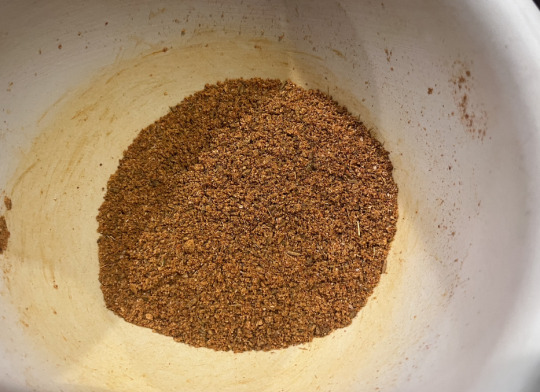

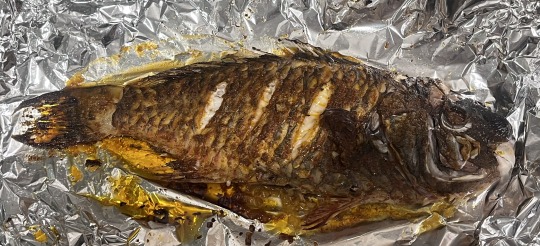
#(Barring the variety of spices) this is a meal an average person could afford every so often. Yams and legumes are something you#eat almost every day and parrotfish would be relatively cheap in coastal cities.#If you're a relatively well-off merchant in the commoner class you might be eating like this pretty often while if you're a peasant this#would be a special occasion but not nearly As special as anything requiring livestock to be slaughtered for your meal.
120 notes
·
View notes
Text
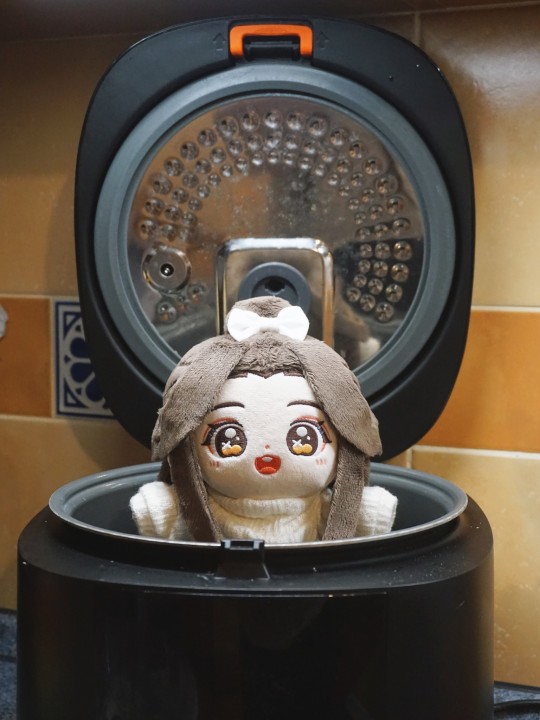
"Surp-ricee!!! Guess what we're doing this evening!!"

"That's right. Mommy is teaching me to cook so I can make dinners for San Lnag every day!
I just hope San Lang will like it..."

"So? How is it, San Lang??"
"It's delicious, gege. A but more salt next time, and it will be perfect!!"
Dinner spotlight:
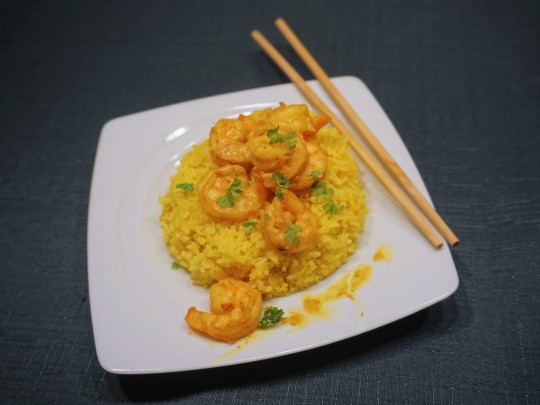
If you'd like to re-create Lianlian's recipe — it'sactually quick and easy!
You'll need long-grain white, garlic, prawns, ginger, salt, pepper, turmeric, coriander powder, cardamom powder, cinnamon powder, cloves powder, lemon juice and plain white yoghurt. (And I think I also used a drizzle of Worchestershire sauce? The whole recipe was kind of an experiment tbh...)
1. Make sure to wash your rice and then place it either to a rice-cooker or to a pot. You're going to prepare rice according to the instructions on the pack (on the rice cooker manual), with a little additional step:
2. Mix the spices together and put half of them in the water with rice. Also add the juice of one lemon before you start cooking it.
3. While your rice is cooking, you're going to fry the prawns in a pan; first of all, put a few sluces of ginger and garlic in the oil. Once you notice they're close to getting burnt, take them out and put them aside. Next, put the prawns into the pan. Then add the rest of the spices. Toss the prawns around on the frying pan for a while until the prawns get nicely coated in all the spices. You can also drizzle a bit of Worcestershire sauce on them.
4. Finally add the yoghurt. That will create a nice sauce. Once both your rice and prawns are ready, you can serve — and optionally, you can add a bit of coriander leaves as garnish ��️
90 notes
·
View notes
Text

[ID: Cooked bitter greens in a bowl with tomato and chili. A garlic mustard rosette is to the left. End ID]
Stewed garlic mustard
Garlic mustard (Alliaria petiolata) is a biennial flowering plant also known as poor man's mustard, hedge garlic, Jack-by-the-hedge, or sauce-alone. It was used in England for various medicinal purposes, including in humorism, from at least the 17th century, and has been eaten on bread and in sauces from the same time.
Nicholas Culpeper, in The English physician (1652), writes that the plant is
eaten by many Country people as Sawce to their salt fish, and helpeth well to digest the crudities and other corrupt humours engendred thereby [...].
George Nicholson, in On Food (1803), writes that garlic mustard
is a very common plant in hedge rows, the leaves of which are eaten by poor country people with their bread, and on account of the relish given, they call it sauce-alone.
Garlic mustard has been introduced to many parts of the United States, where it can be harmful to an area's biodiversity. Garlic mustard is an early sprouter and prolific spreader that can easily outcompete native plants, and it produces a toxin that can limit other plants' growth. Garlic mustard plants should be uprooted before they can produce seed pods.
This stewed garlic mustard recipe rounds out the plant's signature garlicky zest with fresh ginger, bay leaf, cumin, and coriander. A green chili adds flavor and heat, while mustard oil plays up the mustardy notes of the plant.
Patreon | Paypal | Venmo
Ingredients:
100g garlic mustard leaves and shoots
1 roma tomato, diced
1/2 red onion, diced
1 tej patta (Indian bay leaf)
1 green cardamom pod, crushed
1 tsp cumin seeds
1 tsp coriander seeds
3 slices ginger
1 green chili, slit
1 Tbsp mustard oil
Salt to taste
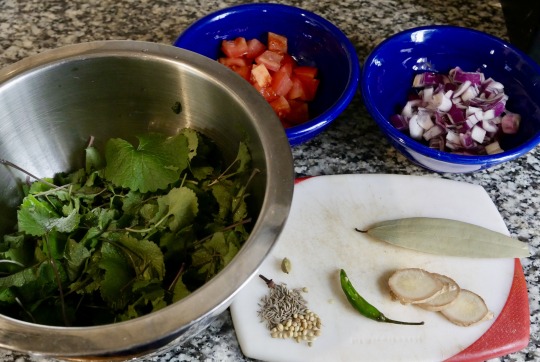
Instructions:
1. Wash and taste your garlic mustard. If it is especially bitter, boil it for 10 minutes and discard the water; or soak it in cold water overnight.
2. Heat oil in a pan on medium heat. Add whole spices (coriander, cumin, cardamom, ginger, chili, bay leaf) and fry for a minute, until fragrant. Take care not to burn the cumin seeds.
3. Add onion and fry for 5-8 minutes, until browned.
4. Add tomato and salt and cook until softened and mostly dry.
5. Lower heat. Add garlic mustard and cook for 5-10 minutes, until softened. Add a bit of water if necessary.
Identifying garlic mustard
Garlic mustard grows from a thin, white taproot that smells similar to horseradish. It has a two-year growth cycle. In its first year, its leaves are more rounded, and grow from a basal rosette; in the second year, the leaves are more pointed and heart-shaped, and grow on petioles from an upright stem. The leaves smell of garlic when crushed.
In the first year, leaves are hairless and deeply veined, with scalloped margins.

First-year garlic mustard
During the second year, flowers have four white petals and grow in clusters from the top of the stalk. Leaves are hairless, alternate, coarsely toothed, and pointed to cordate (heart-shaped).
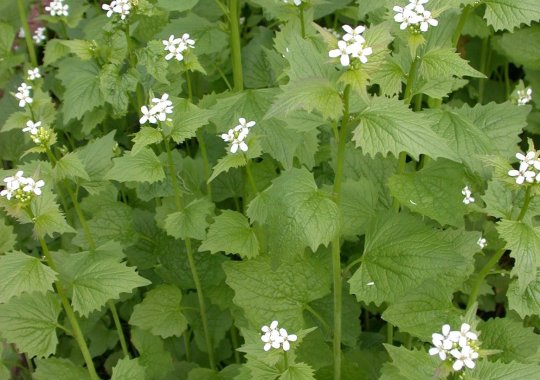
Second-year garlic mustard with flowers

Close-up of flowers
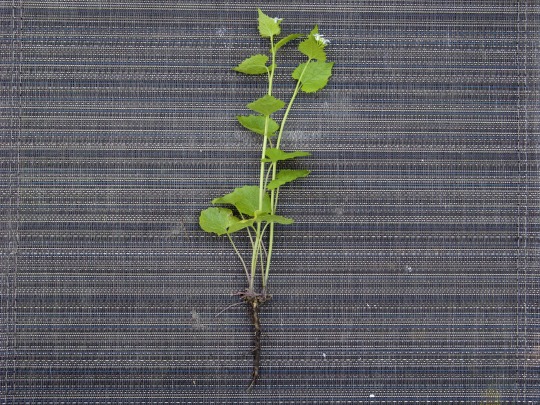
Second-year garlic mustard with root
Lookalikes
At first glance, first-year garlic mustard may resemble ground-ivy. However, ground-ivy has smaller, more circular leaves, which grow opposite (not alternate) on their stems. Ground-ivy grows along stolons (creeping stems), not in basal rosettes. Ground-ivy is also edible.

Ground-ivy
38 notes
·
View notes
Text
#whole coriander seeds#coriander seeds uses#health benefits of coriander#cooking with coriander seeds#coriander seed flavor#medicinal properties of coriander#whole coriander spice#coriander seed nutrition
0 notes
Text
Because all of my coworkers are an absolute disgrace to the art of cookin and @district23gourmet can't stop whinin about my friends... I'm gonna post my favorite curry recipe modified to accommodate the fact that I hardly taste anythin.
For the ingredients...
"Fine chop 1 large onion to make 1 cup chopped
Fine chop or puree 3 medium sweet tomatoes to make 1 cup puree
Make a small slit on 1 spicy pepper (I prefer anythin between ghost peppers and Carolina reapers)
Grate or crush ginger and garlic to make 2 tbsp paste or 2 tablespoons each gratings or crushed.
To make cashew cream, soak 20 cashews in 1/2 cup hot water and keep aside. Alternately you can use half cup thick coconut milk or 1/2 tablespoons nut butter."
3/4 to 1 cup carrot (peeled, chopped, 1 medium)
1/2 to 3/4 cup fresh or frozen peas
1/2 cup green beans (chopped or French beans)
1/4 cup sweet corn kernels
You will peel and chop 1 medium potato to make 3/4 to 1 cup cubes. Keep them immersed in water until used. Also preраге 11/2 cups cauliflower florets (you can substitute with peas, potatoes & carrots" (which I often do for more flavor) "). Keep the cauliflower florets larger so they don't turn mushy.
2 to 3 teaspoon Kashmiri red chili powder (I found out the hard way if you change the amount of this too much it messes with the texture so I usually add while mixing with the other spices until it looks like enough)
1 teaspoon salt (adjust to taste)
1 tablespoon Kasuri methi (crush in your palms and keep it ready but don't mix with the others)
2 teaspoon Garam Masala or 3 tablespoons Curry Powder or as needed (add a lot)
1 teaspoon turmeric (I haven't found a dinner dish turmeric doesn't make significantly better so go nuts)
2-3 teaspoon coriander powder (or I can't taste it)
2 teaspoons cumin powder (I can't stress enough how important a good spice blend is. Experiment and find what works good for you)
Heat 2 to 3 tablespoons oil in a pan. I love to use curry leaves just for the extra flavor they impart. You may not leave out, because it's where a lot of the flavors come from. Add the Fleave out becausenal whole spices and 1 sprig curry leaves.
1/2 teaspoon cumin seeds (Jeera)
1 bay leaf (and curry leaves)
3 green cardamoms (not optional)
1 inch Ceylon Cinnamon piece (or 1/2 inch cassia, both work)
When the spices begin to sizzle, add finely chopped onions & slit spicy peppers. Saute them until light golden.
Add the ginger garlic & saute until aromatic and loses the raw flavor. This takes about a minute. Do not burn.
Stir in all the ground spices - chili powder, garam masala, turmeric. coriander powder, cumin powder and salt. Save the kasuri methi for later.
Add the chopped/mashed or pureed tomatoes. While the tomatoes cook, make the cashew puree by grinding the soaked cashews with the soaked water (cooled) in a small grinder. If you want you may add more water but you shouldn't because the objective of these modifications is to make the curry taste incredibly strong.
Sauté until the onion tomato masala smells good and begins to release oil. Pour the cashew cream or coconut milk. Reserve some to garnish later.
Add the prepared mixed vegetables like potatoes, green peas, carrots, green beans, corn and cauliflower.
Fry on a medium high heat for 2 to 3 mins. While you saute the veggies heat 1 cup water in a separate pot.
Pour the water and give a good stir.
Cover and cook on a medium flame until the veggies are fork tender. Add more hot water only if required as it cooks. I used 2 cups water, added in 3 batches. Organic veggies usually require more water. If you prefer a dry curry, use less water and cook on a slightly high heat to evaporate the moisture.
When the veggies are soft cooked, taste test and adjust salt & garam masala. Add crushed kasuri methi.
Garnish Vegetable Curry with coriander leaves and the reserved cashew cream or coconut milk. Serve with fluffy rice or couscous typically also a side of bread to dip in.
Go to hell; you aren't allowed to insult my friends, only I can.
#project moon ask blog#limbus company#project moon#ishmael limbus company#the cooking saga strikes again
21 notes
·
View notes
Text
Buy Indian Spices Online at Wabhai Foods – Fresh & Pure
Shop Indian spices online at Wabhai Foods – ginger powder, chole masala, methi seeds, jeera powder, hing, ground ginger & dried fenugreek leaves. Enhance your dishes with Wabhai Foods' hing and asafetida ground. Infuse your cooking with a bold, aromatic touch to elevate its depth and flavor!

#ground hing#hing powder#ginger powder#chole masala#methi seeds#jeera powder#hing#ground ginger#isabgol#ground coriander#dried fenugreek leaves#fenugreek seeds#turmeric powder#garam masala#ground spices#til seeds#whole coriander seeds
0 notes
Text
#Aromatic Coriander Export#Aromatic Coriander#Coriander#Whole Coriander Supplier#Whole Coriander#Dhania Export#Aromatic Coriander in India#fresh Coriander#Spices#Indian Masala#Exporter#Supplier#Uttar Pradesh#India
0 notes
Text
I need to share this. (@st-just : hearty gruel alert!)
Red lentils. Boil them in a pot all by themselves, with salt, until soft. Skim the Bad Foam (or first wash them many times, until the water's clear). Set them aside.
Take a big skillet, and sauté in medium heat garlic with cumin, coriander seeds, mustard seeds, and ginger. Grate a tomato in there (or however you add tomato in sauces), add fresh parsley or coriander, and stir.
Drop in the red lentils with water, tumeric, lemon juice, AND TAHINI. Mix them together, let them cook for a few minutes more, stir until done. Adjust texture to taste basically, it's up to you if you'll eat with a fork or with a spoon.
Now serve. In the middle of the gruel, plop a spoonful of strained yoghurt, and slice some raw red onion around it. Drizzle some olive oil/lemon on top. Ready? CHARGE.
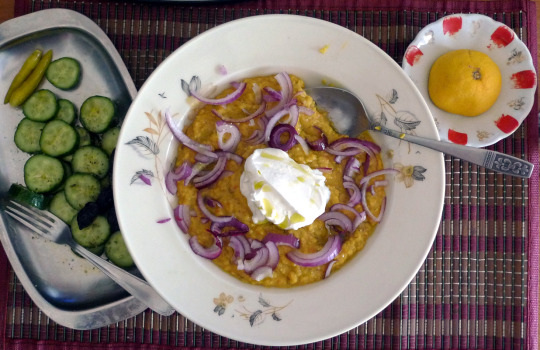
hot lentils (sans parsley, I was out) served in gruel form, a hearty meal for 1
Numbers (approximate), for 2 people
pot:
200 gr red lentils
7 minutes boiling
salt to taste
skillet:
2 cloves of garlic
1 teaspoon cumin
1/2 teaspoon coriander seeds
1/2 teaspoon mustard seeds
1/2 teaspoon ground ginger [I don't actually KNOW numbers for the spices, I'm eyeballing this; do what you will]
1 big tomato
salt and pepper to taste
+2 minutes stirring
skillet with the lentils:
~1/2 cup water (IF you've strained the lentils; I empty most but not all of the water from the pot, and then unceremoniously plop the whole thing in there)
1 teaspoon tumeric
4 tablespoons tahini
1/2 lemon
8 minutes cooking total
per serving:
1 hefty tablespoon yoghurt
1/2 small red onion
olive oil and lemon to taste
Feel free to play around with spices and seasoning. The only essential ingredients are the lentils, oil+tomato+cumin, and tahini+lemon.
It's completely feasible with brown lentils, except they take longer to boil. Basically this recipe combines the standard "brown lentils + tahini" with "red lentils + a bunch of spices".
If you have iron deficiency, the dairy will inhibit the iron absorption from the lentils, so either skip the yoghurt, or decide you're eating this because it's delicious, and not because it's good for your blood.
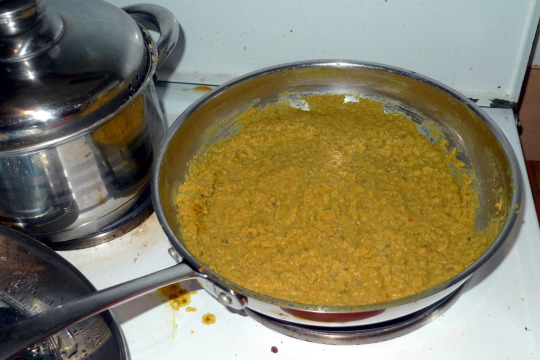
cold lentils ~8 hours later, now in spread-ish form, kinda like hummus. reheating not necessary, fantastic mezze for 2. lasts in the fridge for 3-4 days (just let it out to acquire room temperature first, and serve with yoghurt and onions again).
106 notes
·
View notes